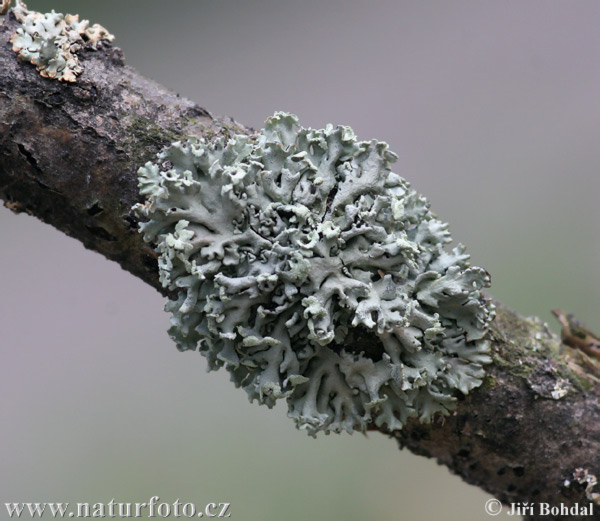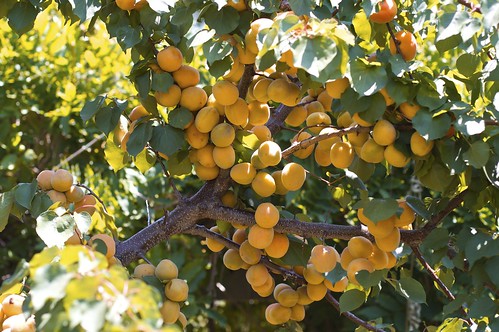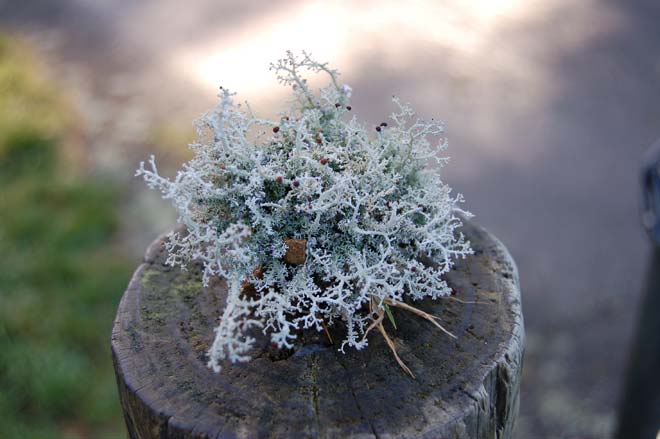Note: This is an alternate assignment for the aquarium field trip
Analogous structures: the forearm bones are different for each of the above animal but have the same basic primary structures. The bones of the arms have drastic size differences and purposes and have developed over many many generations from evolution. For example, the fingers in the bat are elongated to support its "wings" and the forearm bones of the whale are thickened and shortened to make it stronger.
Animal with segmented body: this millipede demonstrates many segments in its body. The segments grouped together usually look very alike and carry out a similar purpose for the animal. These can be regarded as train cars on a train with the same contents inside
Anther and filament of stamen: the anthers are the brown structures containing pollen grains that surround the pistil (six). These pollen-containing structures are supported by the thin green stalk in the photograph, the filament. These anthers are mature and have turned inside out to expose the pollen
Autotroph: An organism that produces its own food, without consuming other organisms. The above is a wild strawberry plant which has green leaves. The leaves contain chlorophyll, which carry out photosynthesis. Photosynthesis produces carbohydrates for the plant using sunlight, and CO2.
Basidiomycete: This jelly fungus is a basidiomycete, belonging to the phylum basidiomycota, or club fungi. Club fungi reproduce by using basidiospores (asexually), and they can produce a fruiting body (the picture) overnight. The cells of the mycelium have cross walls, but cytoplasm can pass through it.
Bilateral symmetry: The above butterfly is bilaterally symmetrical. It is able to be cut in half vertically to produce two identical (but dead), pieces. It is not, however, possible to cut it into more than two pieces and to end up with identical pieces. Hence, bilateral symmetry.
Cellular respiration: This is when your cells turn glucose and oxygen into CO2, H2O, and energy. This cat is eating food which its digestive system will turn into glucose. Mitochondria from its cells will turn the glucose into energy for the cat.
Coevolution: The above hummingbird and the flower it is trying to feed on have gone through a process called coevolution over many generations. In this case, the two organisms are evolving structures that benefit each other and make them well suited to one another. The plant makes nectar from its flowers harder to reach with deeper flowers, and the hummingbird develops a longer beak to reach the nectar while spreading the flower's pollen.

Commensalism: This is a symbiotic relationship between two organisms where one benefits and the other is unaffected. In this case, the barnacles get a free ride in the water to food via whale express. The whale is not affected by its presence.

Cuticle layer of a plant: The shiny coatings on the above Canary Beech leaves are its cuticle layers. A cuticle layer is a shiny, wax-like coating on most plant leaves. Its main function is to prevent water loss. Some people also think the shiny layer is used to reflect light and attract pollinators.
Detritovore: They are heterotrophs that obtain their nutrients and energy from decaying organic matter such as: leaves, dead animals, and even feces. They are also called saprophages. This blue crab feeds off of dead marine animals that have washed up ashore.
Endosperm: The endosperm is the fruit of the apple plant. The endosperm does not include the seeds inside of the ovaries, but the sweet flesh that we eat. The endosperm exists in a triploid stage, or 3N. It is produced when the pollen grain produces sperm that fertilizes the polar nuclei in the process of double fertilization.
Enzyme: In our stomachs, enzymes aid in the digestion of food. Enzymes are proteins that aid to make chemical reactions (in this case, digestion) occur faster. Enzymes are not broken down after they take effect, therefore are technically not "used" by the body. They are extremely inportant in our digestive system as well as making juice, making rubber, and cleaning contact lenses.
Eubacteria: One of the four types of bacteria. The other three are cyanobacteria, archaebacteria, and prochloralbacteria. Eubacteria literally means "true" bacteria (but aren't the three groups are also bacteria?).
This group of bacterial also have cell walls made of complex carbohydrates and some photosynthesize. The above picture shows some of the bacteria of E. Coli. These bacteria also have flagella.
Eukaryote: Eukaryotes are organisms that have more complex cells than prokaryotes. These organisms may be unicellular or multicellular. The cells contain membrane-bound organelles. Eukaryotic cells have a nucleus where genetic information is stored. The above mushroom is a eukaryote because it is multicellular and it has nuclei in its cells.
Flower ovary: The flower ovary contains the egg and polar nuclei. It is fertilized when the gametes produced by the pollen travel through the style and fuses with the egg and polar nuclei. The above flower is from Corn spurry with the ovary being the obvious yellow-green (round-ish) structure in the centre of the flower. It will grow to become the fruit.
Gymnosperm male cone: The cones used to produce pollen grains that are carried by the wind. Have soft overall texture. They are smaller than the mature female cones (middle). On this pine tree, the male cones surround the immature female cone. Self-pollination on this tree is not possible.
Gymnosperm leaf: Needle-shaped leaves that prevent water loss due to each individual leaf's low exposure to air. The leaves of this Douglas fir are pointy but abundant, which increase the total surface area exposed to sunlight. These leaves do fall off, contrary to the name "evergreen", but new ones are constantly replacing the dead leaves. They are covered with a very thick outer cuticle to further prevent water loss.
Lichen: Not actually a plant, but a symbiotic relationship between fungus and a green alga or a cyanobacterium. The two then produce a structure called thallus, which is unrelated to both the organisms. The above is a foliose lichen. The fungus provides protection for the alga/bacteria against harsh climate conditions and the alga/bacteria, provides the fungus with sugars.
Modified leaf of a plant: The aloe vera plant has very obvious modified leaves. The leaves of this plant are fleshy, and modified to a very thick leaf. These leaves hold much water, acting like the stem of a normal plant, These leaves will shrivel up in dry conditions and will expand again when rainfall is plentiful. This allows the plant to survive dry conditions longer than many other plants.
Mycorrhizae: Apricot trees form symbiotic relationships with fungi called a mycorrhizae. This is usually a mutualistic relationship where both the fungi and the apricot trees benefit. The fungus wraps around the plants root with its own mycelium and then absorb minerals and other nutrients for the plant because of the increased surface area. In return, the green plant gives the fungus sugars for it to survive
Phloem: This above flower is a lotus, which is a dicot. Plant that are dicots have their stem structures arranged differently than in monocots. Here, the phloem is arranged in a circular ring near the outside of the stem along with the xylem. The phloem is a tube consisting of cells that are living, which carry the products of photosynthesis down or up depending on the site of photosynthesis. This is why the phloem cells have to be living; they need to "know" which way to pump the nutrients.
Pollen: Pollen is the male gametophyte of gymnosperms and angiosperms. These are the structures that produce male gametes when they come in contact with the female gametophytes and will fertilize the eggs. The pollen on this lily flower is located in the anther, which will be spread by pollinators.
Rhizome: A rhizome is a horizontal stem that grows underground. This stem is swollen with food for the plant in the winter months where the food is little. The iris shown is an good example of a perennial that grows rhizomes. Not to be confused with rhizoid (like me!) which holds the organism to the ground.
Sporophyte: The sporophyte is the diploid generation of plants. In more simple land plants, this is the smaller of the two (sporophyte and gametophyte), but in more complex land plants, like this fern, the sporophyte generation is dominant. A sporphyte produces spores in sporangia, and release them when they are mature. The spores can settle in a new area and germinate into a gametophyte if conditions are favourable.
~End~
























.jpg&container=blogger&gadget=a&rewriteMime=image%2F*)










